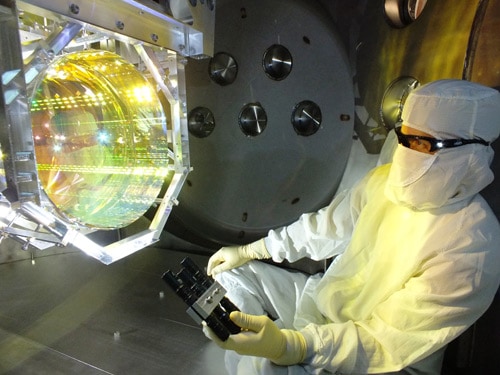
By Hamish Johnston
For the past few days, rumours have been swirling that the Advanced Laser Interferometer Gravitational-wave Observatory (Advanced LIGO) has detected gravitiational waves. Advanced LIGO comprises two huge (kilometre-sized) interferometers in the US, which began taking data in September 2015. The source of the rumours seems to be the physicist and author Lawrence Krauss, who wrote on Twitter yesterday that “My earlier rumour about LIGO has been confirmed by independent sources. Stay tuned! Gravitational waves may have been discovered!! Exciting.”
And it would be very exciting, except for the fact that LIGO spokesperson Gabriela González of Louisiana State University has since told the Guardian newspaper that “The LIGO instruments are still taking data today, and it takes us time to analyse, interpret and review results, so we don’t have any results to share yet.”
So is González exercising the appropriate caution needed when faced with a groundbreaking discovery that must be first confirmed or has Krauss got the wrong end of the stick?
Only time will tell, but in the meantime if you want to know more about Advanced LIGO and the search for gravitational waves, then there is a wealth of information here on physicsworld.com. A good place to start is the 100 Second Science video “What is a gravitational wave?” below in which Ben Stappers of the UK’s University of Manchester explains how gravitational waves are the astrophysical equivalent of throwing a stone into a pond.
[brightcove videoID=3494218922001 playerID=106573614001 height=344 width=500]
Next up is Nergis Mavalvala of the Massachusetts Institute of Technology, who played a crucial role in developing the quantum optics used in the upgrade from LIGO to Advanced LIGO. In the 100 Second Science explainer below she describes how the observatory uses interferometry to search for the effect of gravitational waves here on Earth.
[brightcove videoID=4471065548001 playerID=106573614001 height=344 width=500]
Mavalvala also spoke to Physics World’s Louise Mayor in June 2015 about what Advanced LIGO might detect when it started taking data in September. In the video below she suggests that gravitational waves created by the coalescing of two black holes will be the first to be detected by Advanced LIGO – so if Krauss is correct, maybe the Advanced LIGO team is no trying to verify such a measurement?
Now that your appetite has been whetted, there is lots more about gravitational waves – and what they can tell us about the cosmos – here on physicsworld.com. A good place to start is the feature-length article “Sounding out the Big Bang” by the astrophysicist Craig Hogan. This looks at the spectrum of gravitational waves from the extremely low-frequency gravitational waves imprinted on the cosmic microwave background all the way up to the relatively high-frequency signals that may have been seen by Advanced LIGO.



